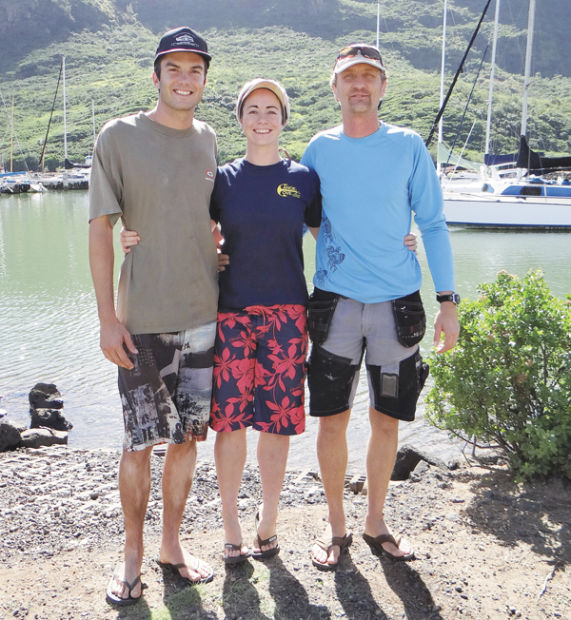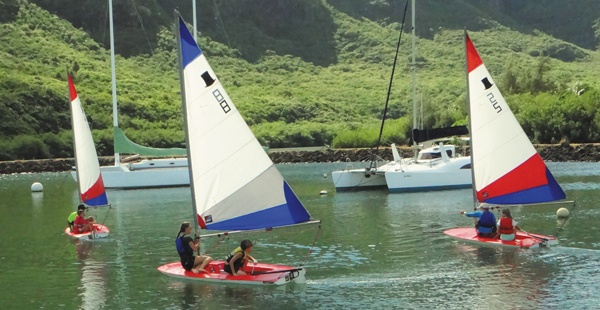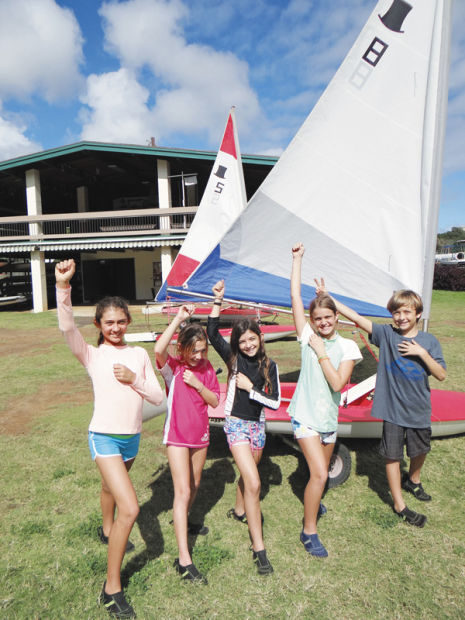Come sail away
Learning to sail small boats is a lot of work but the Kauai Sailing Association wants to help more kids and adults enjoy the experience while becoming good sailors.
The “Learn to Sail” program started in 2008 as a project of the Nawiliwili Yacht Club. The project formalized with the addition of Shale Ame as KSA executive director in 2011 with a goal to ensure next-generation membership by creating young sailors today.
“This has been our full time dream since I moved here,” Ame said.
Raised in Canada, Ame said she always wanted to sail and while at college in Oregon, she took a one semester land-based sailing class in Massachusetts, and then a semester at sea aboard a science and sailing excursion out of San Diego.
The trip concluded its search of water masses and samplings in Hawaii. She fell in love with sailing and the islands.
“After that I was pretty much hooked,” Ame said. “I went home and bought a boat and tried to teach myself how to sail, but it was painful and embarrassing and I didn’t get it for a long time. I would have been so happy if there was something like this to learn from.”
Ame met NYC board members at a farmer’s market and started volunteering until she took on the new KSA project. The Yacht Club is also a nonprofit and makes space available in exchange for renting out the boats when not used in classes.
The classes promote amateur sailing, safe boating, maritime education and exploration. There are Thursday and Sunday youth classes with beginner classes that alternate bimonthly for youth and adults.
There is a swim test before every new class. Students need to be able to swim 50 yards and tread water for three minutes.
“Kids just want to have fun and make friends and feel good about themselves,” Ame said. “We put them together and make them do everything as a team so they are a crew. They are so proud of themselves.”
Some of the older kids are now junior crew members in the race competitions. One 13 year-old was able to helm a boat during a leg of a recent race series, Ame said.
Sailing is also a college competition at many schools and learning to sail might be a plus in open admission and even scholarships, she added.
“Harvard, Yale and Stanford have really good sailing teams,” Ame said. “It’s a really nice way to try to tip the balance in your favor as much as volunteer work.”
Tess Fuller, a volunteer from Kilauea, started racing sail boats in college and started helping with youth summer classes after meeting Shale.
“There are sailing camps everywhere and that is how I learned to sail at age 10,” Fuller said. “Since then I have sailed all over Europe and now Hawaii.”
Recreational sailing is just as rewarding, she said. There is a connection with the water and from being out there and you see things from a perspective that is not possible from the land or air.
The kids in her class would agree.
“I already have a sailboat and I really want to learn more,” said Xaveria Rodriguez, 11, of Kalaheo.
“I just really enjoy sailing,” said Brianna Ryan, 11, of Kapaa. “I think it’s really fun and I enjoy going in the water.”
“I like going fast,” said Malia Splittstoesser, 11, of Lihue.
“The whole homeschool was doing it so we did and it’s fun,” said Jackson Gamby, 11, of Kapahi.
“It’s fun and I like to swim and go in the water,” said Zeke Gamby, 9, of Kapaa.
KSA Board Chair Carl Andersson is from Sweden via California and has sailed since he was seven years old. After several trips to Hawaii to refurbish boats he and his spouse moved to Kauai in 2008.
“The feeling of being in touch and in tune with the ocean is much bigger in the sailboat than I ever held in a powerboat,” he said. “You are actually relying on weather, wind, tide and your own knowledge to get places is a very empowering.”
It was while teaching his own daughter how to sail that it occurred to him the KSA needed a program for kids. The KSA started around 2008 as a part-time volunteer activity and added the full-time director position in 2011 to reach more kids around the island.
“This is a brand new thing since last year,” Carlson said.
The experiment started as an immersion school class and they tweaked it to grow from a couple of kids in 2011 to 25 kids today from different backgrounds and schools, he said.
Mark Brewer started with NYC at age 15 and is now crewmember on a racing boat and owns his sailboat. He was appointed to the board on Wednesday.
“Sailing has been in the family for multiple generations,” Brewer said. “My dad sailed over from California when he was 17, and my mom has always been into paddling, canoe and some sailing.”
Now that he is a board member, Brewer said he will work to become certified to teach sailing. He recalled taking a similar programs with NYC volunteers 15 years ago and said it made a difference for him.
It is good to learn the fundamentals before becoming crew on a boat, he said. It is difficult to learn by just following orders, but when in charge of your own boat you know what you are doing and why.
Even though competitive racing and recreational sailing are different in focus and intensity, they both stem from the same school of knowledge. When kids are captains at the helm of their own boat it is empowering, and tempered with responsibility that comes from appreciating the consequences of not using what they learn.
“You get a much better understanding with how things are supposed to be working,” Brewer said. “Any boating activity can be dangerous out there and you should understand the equipment you rely on with your life.”
The curriculum was established by U.S. Sailing and certified instructors oversee volunteers and student classes at Nawiliwili Harbor. As director, Ame trains volunteers to assist with classes and boat maintenance and sends some to Oahu for training.
“We are hoping to increase our skill set with more people involved at a higher level education,” Ame said.
The tuition alone does not keep the program going and it relies on fundraising and grants. The program started with three Toppers and a few old Laser sailing dinghies. Today there are nine Toppers, seven Lazers and four 420s, which are two-person, two-sail dinghy boats for intermediate classes.
Ame has a degree in marine biology and her work includes projects with the Department of Fisheries and Oceans in Canada, and the U.S. National Oceanic and Atmospheric Administration. Her role as a science educator helps expand the KSA mission into homeschool education.
“We are starting our first marine biology and ecology class with homeschoolers and we hope to make it open to everyone based on interest,” Ame said. “These are kids that have already sailed and have an appreciation for the water and the ocean and what it gives them.
The homeschoolers are doing student driven projects to compare different eco-systems and study factors of pH balance, salinity, temperature. They test samples and brainstorm ways to help the ocean using science.
“It is multifaceted approach for them to learn sailing, the science of the ocean, and about what they can do to help,” Ame said.
The sailing course is $300 for adults and $200 for youth ages 12 to 18 with scholarships available. There is a $50 discount to NYC members. To learn more call 346-7671 or visit www.kauaisailing.org.




